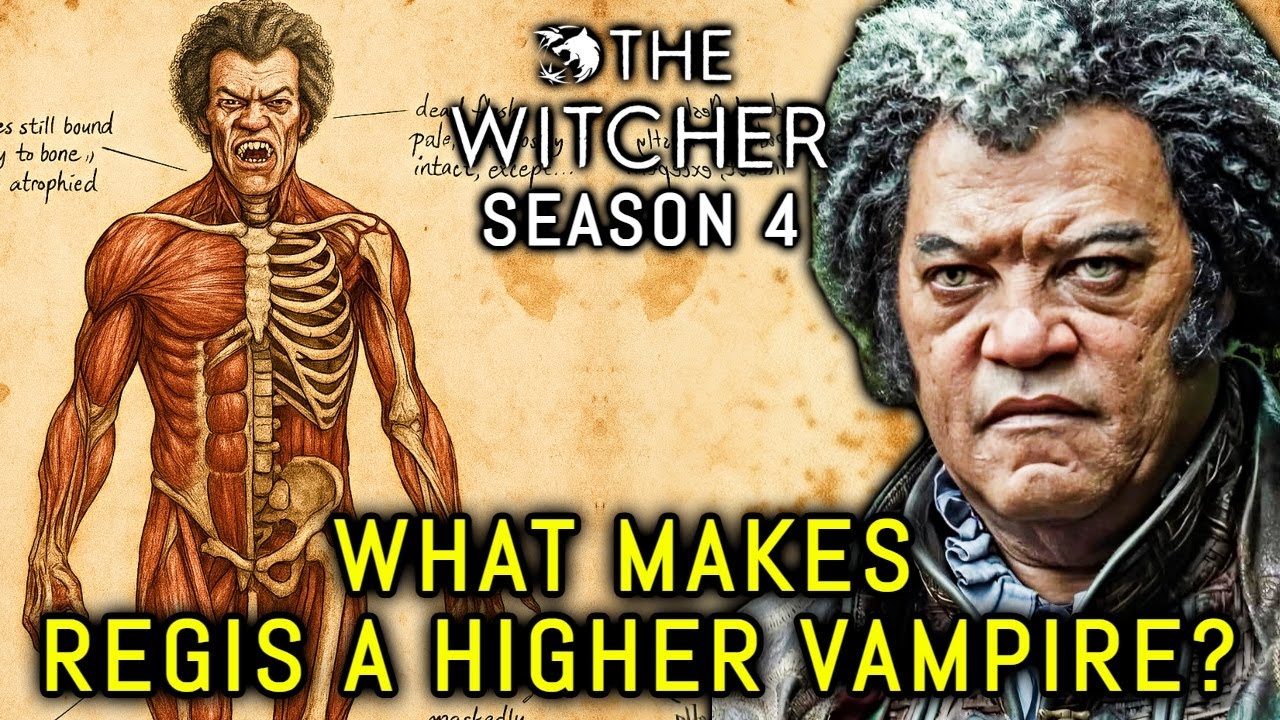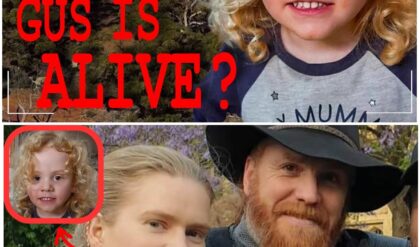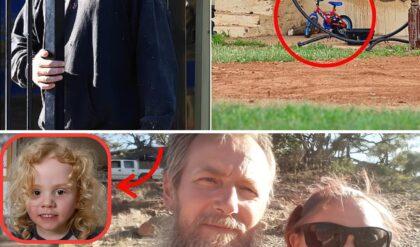🧛♂️⚔️ Witcher fans, sink your teeth in…
Laurence Fishburne’s Regis drops in Season 4 as the ultimate vampire ally 😈—over 400 years old, blood-free philosopher with powers that humble witchers. Origins? Born monster. Anatomy? Immortal edge. But why’s he Geralt’s secret weapon?
Bite deeper 👇

Netflix’s The Witcher Season 4, which dropped all eight episodes on October 30, 2025, marks a pivotal shift for the Continent’s lore, thrusting Geralt of Rivia (now Liam Hemsworth in his seamless takeover from Henry Cavill) deeper into Andrzej Sapkowski’s saga with a ragtag “hansa” of allies hunting for the elusive Ciri (Freya Allan). Amid the chaos of Nilfgaardian incursions, mage cabals, and prophetic visions, one newcomer steals the shadows: Regis, portrayed with magnetic gravitas by Laurence Fishburne. Introduced in Episode 3 as a cryptic barber-surgeon patching wounds in a fog-choked elven cemetery, Regis evolves from enigmatic healer to Geralt’s philosophical anchor—a higher vampire whose centuries of wisdom challenge the witcher’s black-and-white monster code. Drawing from Sapkowski’s 1996 novel Baptism of Fire (the fifth in the saga), the show adapts Regis as a blood-abstaining sage whose bond with Geralt humanizes the hunter, but with Netflix’s tweaks for emotional depth and visual flair. As Fishburne told Tudum, “Regis is on his own path of redemption… a vampire who shares Geralt’s mutation vibe, but eternal.” With Season 4’s 91% Rotten Tomatoes score and 150 million hours viewed in Week 1 (per Nielsen), Regis isn’t just a fan-favorite import—he’s the undead heart of Geralt’s introspection arc.
At 400+ years old, Emiel Regis Rohellec Terzieff-Godefroy isn’t your garden-variety fang-banger. Born a higher vampire—not bitten into monstrosity—he’s a polymath exile masquerading as Dillingen’s unassuming surgeon, blending herbal lore with scalpels and sarcasm. In the books, Geralt sniffs him out instantly but honors the code: Sentient beasts like Regis get a pass if they don’t prey. The show amps this tension—Geralt’s early wariness cracks during a witch trial ambush in Episode 4, where Regis’ subtle saves (a hypnotic glance averting arrows) forge trust. Fishburne’s casting, announced January 2024, was a coup: His Morpheus gravitas infuses Regis with quiet menace, turning campy vampire tropes into poignant redemption. As showrunner Lauren Schmidt Hissrich noted, “Regis forces Geralt inward—emotions aren’t weaknesses; they’re survival.” But beneath the velvet cape lies a anatomy of ancient horror: Origins rooted in cosmic calamity, powers that eclipse witcher mutations, and a biology defying death. Here’s the breakdown you need before Season 5’s looming Vilgefortz showdown.
Origins: Born of the Elder Blood, Not a Curse
Regis’ backstory isn’t a tragic bite—it’s primordial predestination. In Sapkowski’s lore, higher vampires like Regis hail from the Conjunction of the Spheres (circa 1,500 years pre-series), a multiversal cataclysm slamming elder races (elves, demons) into the Continent. Unlike lesser vampires—feral, bite-born pests—higher ones are “true” immortals, spawned from cosmic rifts as apex predators with human guile. Regis emerged fully formed in the 12th century, a noble-born anomaly amid Toussaint’s vineyards, his full moniker (Emiel Regis Rohellec Terzieff-Godefroy) a nod to aristocratic roots lost to vampiric exile.
Season 4 flashbacks (Episode 6’s campfire confessional) adapt this elegantly: Young Regis, wide-eyed in 15th-century France-analog, experiments with bloodlust—seducing villagers, draining foes—until a botched romance shatters him. In the books, it’s a 17th-century fling with a herbalist named Bethsada (cut for pace here), ending in a mob’s fury: Decapitated, staked, burned, and buried, Regis regenerates over 50 years in a grave, emerging vowing abstinence. Netflix tweaks for pathos: His lover’s suicide mid-feed, witnessed by torch-wielding peasants, mirrors Geralt’s Renfri regret—both men haunted by “necessary” kills. Fishburne leans into the torment: “Regis chose peace after seeing his reflection in blood… like Geralt post-mutation.” This origin cements his outsider status: Not cursed like a bruxa, but innate like a witcher—mutated by fate, not choice.
Tying to broader lore, Regis embodies vampire hierarchy: Katakans and nosferats as brutish kin, but higher vampires like him (or Dettlaff from The Witcher 3: Blood and Wine) rival Elder Blood mages in potency. His “birth” during the Conjunction echoes Ciri’s Elder lineage—both harbingers of chaos, but Regis chose restraint, fleeing courts for barber’s blades. In Season 4, this fuels his mentorship: Spotting Geralt’s Ciri obsession, he quips, “Immortality’s curse isn’t eternity—it’s watching loves rot.” A subtle pivot from books, where Regis’ intro is quippier, emphasizing his show arc as Geralt’s mirror: Eternal wanderers seeking family in a world that hunts them.
Powers: Immortal Arsenal Beyond Witcher Mutations
Higher vampires aren’t flashy fireworks—they’re surgical shadows, powers honed over centuries into elegant lethality. Regis’ arsenal, unveiled in Season 4’s Episode 5 skirmish (a Nilfgaardian ambush where he vanishes a squad mid-charge), dwarfs Geralt’s signs: Subtle, inexhaustible, and psychologically devastating. Foremost: Immortality and Regeneration—decapitation? A 50-year nap. Stakes through the heart? Mere indigestion. In the books, Vilgefortz’s lava bath barely singes him; the show nods this in a teaser brawl, Regis shrugging off crossbow bolts like rain.
Superhuman Strength and Senses: He crushes skulls bare-handed (restrained here for alliance vibes) and hears heartbeats across rooms—key in Episode 7’s stealth rescue of Jaskier from Dijkstra’s (Graham McTavish) dungeon. Hypnotic Gaze/Mesmerism: A stare freezes foes in thrall, compelling truths or obedience—used sparingly on a torture-happy guard, echoing Morpheus’ red-pill philosophy. Shapeshifting: Fluid forms—bat swarms, mist clouds, even illusory duplicates—aid escapes, like Episode 4’s trial diversion where “Regis” multiplies amid flames.
Telepathy and Flight: Mind-probes glean secrets (sensing Milva’s (Meng’er Zhang) dryad ties in Episode 6), while levitation whispers through shadows—perfect for hansa ambushes. Blood-abstinence dulls peaks but sharpens intellect; he sustains on “life essence” via touch, a show invention blending book vagueness with visual restraint. Fishburne nails the duality: “Power’s a burden—Regis wields it like a surgeon’s knife, precise, not savage.” Versus witchers? Silver swords bounce off; Igni fizzles on regen hide. Only another higher vampire (Dettlaff tease?) ends him—foreshadowing Season 5’s Toussaint arc.
In gameplay nods (Blood and Wine), Regis’ powers shine in co-op illusions; the show adapts for drama—his telepathy unlocks Geralt’s Ciri visions, bonding over shared “otherness.”
Anatomy: Eternal Engine of Blood and Shadow
Vampire biology in The Witcher is eldritch engineering—higher ones like Regis blur undead and alive, a perpetual motion machine of vitae and void. Heart beats faintly, pumping ichor-thick blood that clots wounds instantly; skin pales to marble but warms on “feed” (Regis skips, staying cool as a crypt). Fangs retract like cat claws, venom-laced for hypnosis—Season 4’s close-up (Episode 3 surgery) shows retractable incisors glinting under lantern light.
Internally? Organs redundant—liver filters “essence” from air/plants, lungs optional for mist-form breath. Sunlight? Mild itch, not blaze (higher perk over lesser ashers). Garlic, holy symbols? Laughable myths. Weakness? Decapitation stalls regen, but immersion in silver-laced soil (books) or another higher’s bite accelerates recovery. Show-exclusive: Abstinence thins blood, granting clarity but risking “fade”—a pallor hinting relapse, visualized in Episode 8’s fever dream where Regis’ veins blacken like Geralt’s post-potion scars.
Anatomy ties to origins: Conjunction “mutants,” veins pulsing elder energy akin to Ciri’s portals. Fishburne’s physicality sells it—veins subtly threading under eyes during telepathy, a nod to Matrix code-veins. As Regis tells Zoltan (Danny Woodburn) over ale: “Body’s a cage; mind’s the key.”
Aspect
Book Lore (Sapkowski)
Show Adaptation (Season 4)
Game Tie-In (Blood and Wine)
Origins
Born higher vampire, 12th-century Toussaint exile
Cosmic Conjunction spawn, tragic romance pivot
Revived post-books, Dettlaff debt
Powers
Regen, hypnosis, shapeshift, flight
Telepathy bonds Geralt, mist escapes
Illusion co-op, Unseen Elder summit
Anatomy
Ichor blood, retractable fangs, sun-itch
Abstinence “fade,” vein-glow visuals
Blood-alchemy brews, mist-form stealth
Weaknesses
Only higher vampire kill, 50-year regen
Emotional relapse risk, silver soil slow
Dettlaff betrayal, Elder confrontation
Regis’ Impact: Redemption’s Blade in Geralt’s Quest
Season 4’s Regis isn’t filler—he’s catalyst. Joining the hansa (with Milva’s archery, Zoltan’s grit), he heals Jaskier’s (Joey Batey) bardic wounds while probing Geralt’s paternal voids: “Hunt monsters, but fear the man in the mirror.” His reveal (Episode 4 trial blaze) flips dynamics—Geralt spares him, echoing Yennefer’s (Anya Chalotra) lodge fractures. Books end with his Vilgefortz sacrifice; the show teases Toussaint DLC vibes, Fishburne confirmed for Season 5’s vampire conclave.
Challenges? Pacing juggles hansa hijinks with Ciri’s Rats arc, but Fishburne’s restraint elevates: No campy fangs, just weary eternity. X raves: “Regis > Morpheus—undead therapy session.” As Geralt’s band fractures toward Thanedd coup echoes, Regis whispers the saga’s soul: Power corrupts, but wisdom endures.
Stream Season 4 now—Regis awaits in the cemetery mist.





